
The Old Pack Horse is a Grade II listed public house in a prominent position on the corner of Chiswick High Road and Acton Lane in Chiswick, London. [1]

The Old Pack Horse is a Grade II listed public house in a prominent position on the corner of Chiswick High Road and Acton Lane in Chiswick, London. [1]
The current structure was built in 1910 [2] by the architect Nowell Parr, the house architect of Fuller, Smith & Turner, who ran the local brewery. [1] It is a red brick structure of three storeys, with decorative terracotta and coloured tiles. It has remained unaltered since its construction. [1] The building historian Nikolaus Pevsner writes that it has "plenty of jolly terracotta detail and bowed ground-floor windows". [3]
The English Heritage listing describes it as the "best preserved example of a public house by the Fuller, Smith and Turner house architect". [1]
The first pub on this site, the "West Country Packhorse", was granted a licence in 1759. It was renamed as the "Lower Pack Horse" in 1790, and again to be the "Pack Horse" sometime before 1811. It was acquired by Fuller, Smith & Turner in 1808. [2]
The Friends of Turnham Green cited the overshadowing of the pub in their successful objection to the development of the whole of the adjacent part of Chiswick High Road and area behind it in 2015. [4]

Chiswick is a district of west London, England. It contains Hogarth's House, the former residence of the 18th-century English artist William Hogarth; Chiswick House, a neo-Palladian villa regarded as one of the finest in England; and Fuller's Brewery, London's largest and oldest brewery. In a meander of the River Thames used for competitive and recreational rowing, with several rowing clubs on the river bank, the finishing post for the Boat Race is just downstream of Chiswick Bridge.

Fuller's Brewery in Chiswick in the west of London was a family-run business from its foundation in 1845 until 2019. In that year, the brewing division of Fuller, Smith & Turner PLC was sold to the Japanese international beverage giant Asahi.

Fuller, Smith & Turner is a public limited company based in London, England. Its origins lie in John Fuller's Griffin Brewery, which dates from 1816. In 1845, John Fuller's son, John Bird Fuller, was joined by Henry Smith and John Turner to form the current company.
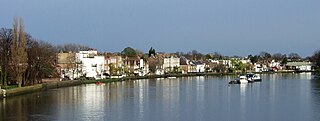
Strand-on-the-Green is one of Chiswick's four medieval villages, and a "particularly picturesque" riverside area in West London. It is a conservation area, with many "imposing" listed buildings beside the River Thames; a local landmark, the Kew Railway Bridge that crosses the River Thames and the Strand, is itself Grade II listed. Oliver's Island is just offshore.

Turnham Green is a public park on Chiswick High Road, Chiswick, London, and the neighbourhood and conservation area around it; historically, it was one of the four medieval villages in the Chiswick area, the others being Old Chiswick, Little Sutton, and Strand-on-the-Green. Christ Church, a neo-Gothic building designed by George Gilbert Scott and built in 1843, stands on the eastern half of the green. A war memorial stands on the eastern corner. On the south side is the old Chiswick Town Hall.

The Tabard Theatre is a small 96-seat theatre in Chiswick in the London Borough of Hounslow. Close to Turnham Green Underground station, it is situated above the Tabard public house on Bath Road. The Tabard Theatre was licensed and opened for theatre use in 1985. It was renamed as the Chiswick Playhouse in 2019 which closed in March 2022. It is reopening as the Tabard in September 2022.
Acton Green is a residential neighbourhood in Chiswick and the London Borough of Ealing, in West London, England. It is named for the nearby Acton Green common. It was once home to many small laundries and was accordingly known as "Soapsuds Island".
Grove Park is an area in the south of Chiswick, now in the borough of Hounslow, West London. It lies in the meander of the Thames occupied by Duke's Meadows park. Historically, the area belonged to one of the four historic villages in modern Chiswick, Little Sutton. It was long protected from building by the regular flooding of the low-lying land by the River Thames, remaining as orchards, open fields, and riverside marshland until the 1880s. Development was stimulated by the arrival of the railway in 1849; Grove Park Hotel followed in 1867, soon followed by housing.

The Mawson Arms/Fox and Hounds is a Grade II* listed public house, 110 Chiswick Lane South, Chiswick. The entire terrace of five houses is listed, and they were built in about 1715 for Thomas Mawson; owner of what became the Griffin Brewery. They adjoin one side of Fuller's Griffin Brewery.

The George and Devonshire is a Grade II listed public house at Burlington Lane, Chiswick, London. It was built in the 18th century, but the architect is not known. The pub claims that it dates back to 1650.

Thomas Henry Nowell Parr FRIBA was a British architect, best known for designing pubs in west London. Many of these were built while Parr was "house architect" for Fuller's Brewery. Parr designed various buildings in Brentford while he was surveyor and then architect to the Council from 1894 to 1907.
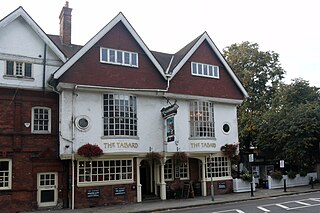
The block of three buildings containing The Tabard public house is a Grade II* listed structure in Chiswick, London. The block, with a row of seven gables in its roof, was designed by Norman Shaw in 1880 as part of the community focus of the Bedford Park garden suburb. The block contains the Bedford Park Stores, once a co-operative, and a house for the manager.

The Tally Ho is a landmark public house in north Finchley, north London, under the management of the Stonegate Pub Company.

Old Chiswick is the area of the original village beside the river Thames for which the modern district of Chiswick is named. The village grew up around St Nicholas Church, founded c. 1181 and named for the patron saint of fishermen. The placename was first recorded c. 1000 as Ceswican. In the Middle Ages the villagers lived by fishing, boatbuilding, and handling river traffic. The surrounding area was rural until the late 19th century.

The Duke of Sussex, Acton Green is a public house, opened in 1898, in the northern Chiswick district of Acton Green. It is prominently situated on a corner facing the common. The Grade II listed building is "elaborately decorated" to a design by the pub architects Shoebridge & Rising.

The Power House, Chiswick is a former electricity generating station on Chiswick High Road and a Grade II listed building, completed in 1901. It provided power for the London United Electrical Tramway Company until 1917. The upper part of the building was converted for residential use in 1985, and the lower part for use as a recording studio in 1989.
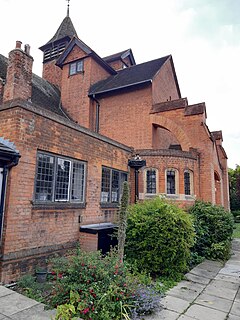
St Michael's Church, Grove Park is an Anglican church in the Grove Park district of Chiswick, opened in 1909. Its red brick architecture by W. D. Caröe & Herbert Passmore has been praised by Nikolaus Pevsner.
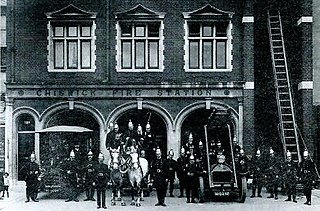
The Old Fire Station, Chiswick is an 1891 brick building with stone facings on Chiswick High Road. It served as a fire station until 1963, and has since been used as a restaurant.

Chiswick High Road is the principal shopping and dining street of Chiswick, a district in the west of London. It was part of the main Roman road running west out of London, and remained the main road until the 1950s when the A4 was built across Chiswick. By the 19th century the road through the village of Turnham Green had grand houses beside it. The road developed into a shopping centre when Chiswick became built up with new streets and housing late in the 19th century. There are several listed buildings including public houses, churches, and a former power station, built to supply electricity to the tram network.
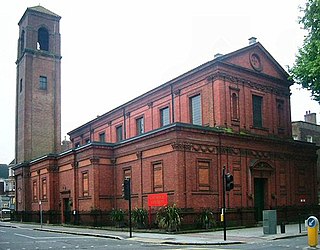
The 1886 Church of Our Lady of Grace & St Edward, serving the Roman Catholic parish of Chiswick, stands on the south side of Chiswick High Road, on the corner with Duke's Avenue.